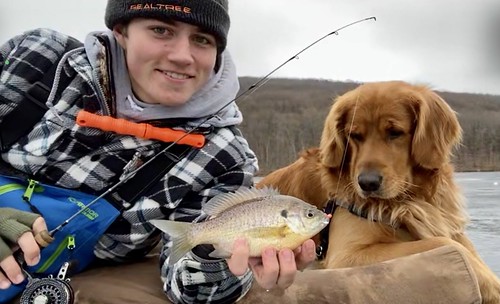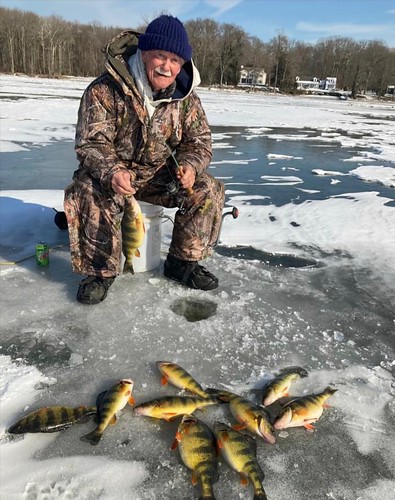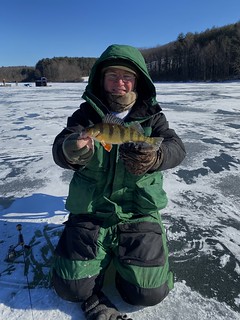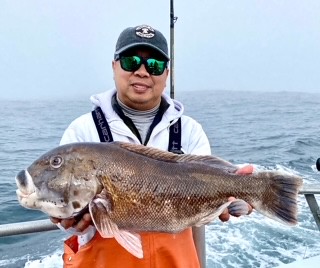
Tommy O’Connell spent some time ice-fishing on Cunningham Reservoir with his buddy Oakley. Photo by Tommy O’Connell
While some retreat when winter temperatures drop and snow and icy conditions prevail, there are anglers who just cannot sit out the winter months. The reservoirs of Western Maryland are providing wonderful ice fishing opportunities for a variety of fish species, and the open waters of fast-moving streams and rivers are providing excellent trout fishing thanks to the pre-season stocking program.
The 2022 recreational striped bass regulations have been finalized and they will stay the same as last year. Currently, all Maryland Chesapeake Bay waters and the Potomac River are open to catch-and-release fishing through February 28. Check the Maryland Department of Natural Resources website for the full set of striped bass regulations.
The flounder regulations will remain at four fish per day with a minimum size of 16.5 inches. The bluefish creel limit will also remain three fish per day with a minimum length of 8 inches. The limit for cobia will be one fish per angler per day with a minimum of 40 inches. There is a limit of two cobia per vessel that has two or more anglers aboard.
DNR biologists will be on hand at the Great American Outdoor Show in Harrisburg, Pennsylvania, until February 13. If you are attending the show, stop by and say hello to our staff at the Fish & Hunt Maryland booth, space 4603.
Forecast Summary: Midwinter:
With Bay water temperatures in the low 40s and upper 30s, fish are now in their winter holding areas. With plenty of cool waters and oxygen from surface to bottom, look for concentrations of fish in some of the remaining warm water areas. In the main Bay, warmer bottom waters deeper than 50 feet are located from the Bay Bridge south to near the Virginia state line, near areas with good structure and protection from strong current such as underwater points, channel edges, and bridge pilings with nearby oyster bottom and reefs. The other warm water areas to consider are near the water discharges of your local power plants.
We will begin our weekly Bay fishing conditions forecasts again in March. However, for those hearty, cold-water anglers, all maps, plots and satellite pictures will be continuously updated and posted. So for detailed and up-to-date fishing conditions in your area of the bay, continue to check out Click before You Cast.
Upper Chesapeake Bay

Herb Benjamin shows his talent for catching yellow perch. Photo courtesy of Herb Benjamin
Persistent anglers are making the best of the cold water and icy conditions prevailing in the upper Bay. When they can find open water, there are yellow perch to be caught in the Susquehanna River, below the Railroad Bridge in the deep hole there. Wind and drift conditions will dictate how much weight one will have to use to get down to where the fish are. A bank sinker with a two-hook dropper rig baited with minnows or small jigs is usually what works best.
There are open water areas in some of the tidal rivers, but many of the upper sections are iced over. In some areas, like parts of the North East River, anglers have found enough ice to venture out for some ice fishing for yellow perch. If you do this, use extreme care and be safe.
Although the banks are icy and slippery, some anglers are able to get a line out into the flowing open waters of the Susquehanna in search of blue catfish. The catfish tend to be in the deeper parts of the river holding close to the bottom. When air temperatures and sunny conditions are favorable, fishing for blue catfish can be a lot of fun and can put some fresh fish on the dinner table. The upper Chester River is another excellent place to fish for blue catfish from shore or a boat; the Crumpton area is often a very good place to fish for them in the deep channel waters.
If catch-and-release fishing for striped bass is on your mind, there are fish holding close to the bottom out near the rock piles and concrete bridge abutments. These fish are so cold that when they are spotted on a depth finder they will look like a stack of cordwood. Chances are if you are jigging over them, you will snag more than actually take the jig. The water is just too cold for them to feed.
Middle Bay

Photo by Keith Lockwood
Most of the fishing action in the middle Bay this time of the year is occurring in the tidal rivers within the region, where anglers are targeting yellow perch. It can be tough to get them to bite, and the best bait tends to be minnows on a simple bottom rig in the deeper waters, or a bobber in some of the shallower areas. It will only be a couple of weeks until the much anticipated spring spawning runs of yellow perch will begin in early March.
Blue catfish and channel catfish offer some of the best fishing opportunities in the tidal rivers. The Choptank River holds the greatest populations of blue catfish at this time and it is expanding. Commercial catfish operations note that their traps are loaded with 8-inch to 10-inch blue catfish in the upper parts of the Choptank. The larger blue catfish are being found deep in the area from the Dover Bridge to the town of Choptank. Channel catfish are a good percentage of the catch and anglers will also see white catfish on their baits. Fresh gizzard shad is one of the top baits but frozen menhaden, scented baits of chicken breast, night crawlers, and even hot dogs can work well. Some anglers soak baits in garlic, strawberry Jell-O powder, menhaden oil, and other concoctions when fresh cut bait is not available.
Anglers looking for striped bass catch-and-release action will most likely be venturing out to the Calvert Cliffs Power Plant warm water discharge on sunny and windless days. Jigging will be the tactic employed while drifting in the current.
The Maryland Park Service will conduct an underwater assessment of the piers at Bill Burton Fishing Pier State Park in Talbot and Dorchester counties to determine what actions are needed regarding the 80-year old former highway bridge. Following the guidance of engineers, these piers have been closed since December 23, 2021 pending a structural inspection, which is now scheduled for this spring. In the meantime, other areas of the Bill Burton Fishing Pier State Park such as the walking trails are still open to the public. Further information and updates can be found on the DNR website.
Lower Bay
Blue catfish and yellow perch await anglers that cannot sit out the winter months without casting a line into their favorite tidal river. Three excellent places to fish during cold weather are the tidal Potomac downriver of the Wilson Bridge, the Patuxent River near Benedict, and the Nanticoke River near Sharpsburg and the Marshyhope. The blue catfish tend to be holding deep in the river channels – anchoring up and placing several baits will keep you busy. These rivers also hold shoreline access areas where deep water can be reached with a skillful cast. The Fort Washington area on the Potomac and the shoreline in the town of Sharpsburg are two good examples.
Yellow perch can be found staging in deep pockets a few miles below the spawning areas in the Patuxent and Nanticoke rivers. A bottom rig baited with minnows is a good bet. Casting a lip-hooked minnow that has a split shot a few feet above it is a great way to work areas and cover water. Small jigs tipped with a piece of minnow can also work well. Based on current water temperatures, it will only be a few weeks before we can expect the yellow perch spawning runs to begin in earnest.
Freshwater Fishing

Tom O’Connell holds up a nice yellow perch caught at Piney Run Reservoir caught while jigging. Photo by Tommy O’Connell
Opportunities abound this time of the year for freshwater anglers. The pre-season trout stocking program is occurring, ice conditions are favorable in many western region reservoirs, and open water areas offer good fishing for chain pickerel.
The pre-season stocking of trout in many of the trout management waters are providing good fishing for anglers. The stockings have been occurring since late December and will continue through February. There is milder weather predicted for the rest of the week and into the weekend, so it will be a great time to get out and enjoy some trout fishing. Be sure to check out the DNR trout stocking website for the latest stocking updates and visit a trout stocked water near you.
Those anglers that look forward to and enjoy ice fishing are having a wonderful time fishing various reservoirs in Western Maryland. Lake Habeeb at Rocky Gap State Park is providing a fun mix of yellow perch, rainbow trout, largemouth bass, and various species of sunfish. Anglers at Piney Run Reservoir are catching limits of beautiful yellow perch. At Cunningham Reservoir those fishing through the ice are catching a mix of sunfish species and largemouth bass. Deep Creek Lake is known for its wide variety of cold water species, and hard water anglers are catching a mix of yellow perch, walleye, chain pickerel, northern pike, rainbow trout, and largemouth bass.
Jigging through the ice with small jigs tipped with wax worms tends to be the ticket for yellow perch and sunfish species as well as trout and the occasional largemouth bass. The Northland Buckshot Forage Minnow has been a very popular choice, while the Swedish Pimple is a tried-and-true standard. Small tungsten jigs in glow colors are also working well. Most jigs being used are in the 1/28-ounce to 1/32-ounce weights. Minnows are a great choice for walleye and larger species and are the first choice for tip ups. A portable depth finder is extremely valuable, as is something to sit on. Most experienced anglers have a sled they can drag along with all of their equipment, including hot beverages.
All ice-fishing anglers need to understand the inherent dangers of walking out on the ice and exercise the utmost care and safety. Always venture out with an extraction device, which resembles two ice picks, to help get a solid grip and extract yourself if you happen to fall through. A layer of snow usually insulates existing ice and will hinder it becoming thicker. Later on this month ice conditions will begin to deteriorate, so this season ends quickly. Dress warmly and enjoy this truly unique way to fish during the winter months.
The open waters of Maryland are drawing anglers looking to fish for chain pickerel, largemouth bass, smallmouth bass, walleye, and muskellunge. The upper Potomac can provide good fishing for walleye, smallmouth bass, and muskie if one is careful of drifting ice and cold water conditions. Fishing deep with jigs and small crankbaits is a good choice for walleye and smallmouth bass; large spinnerbaits, soft plastic paddletails, and jerkbaits are popular choices for muskie.
Chain pickerel are entertaining anglers in the upper sections of the state’s tidal rivers, reservoirs, and small ponds. Vegetation is gone and the pickerel are looking for structure, so fallen tree tops and sunken wood are great places to target. A variety of lures will work including paddletails, spinners, spoons and jerkbaits. Chain pickerel are ambush predators and will attack lures with abandon, so flattening barbs on hooks and replacing treble hooks with single hooks are a good idea both for your fingers and for the fish’s survival.
Largemouth bass can be found holding deep in channel areas in the tidal rivers or deep holes in nontidal waters. Structure is often very important and they will hold tight to sunken wood or any other types of structure. Deep diving jerkbaits and crankbaits are a good choice as are chatterbaits and even spinnerbaits if slow rolled along the bottom. Blade lures are a popular choice, and it is hard to outdo jigs worked slowly along the bottom. Strikes will often be very subtle.
Atlantic Ocean and Coastal Bays

Photo by Monty Hawkins
Fishing for tautog takes center stage during the winter months in the Ocean City area. Tautog are being caught in and around the Ocean City Inlet and the Route 50 Bridge area. It is cold and tough fishing at times and there are a lot of throwbacks, but it tends to be the only show in town for those who just have to wet a line. Frozen sand fleas and pieces of green crab are the best baits.
The party and charter boats that are heading offshore are enjoying excellent fishing for tautog most of the time they go out. There are always fickle water conditions such as currents and other unexplained occurrences that may make one day better than another. Most anglers are targeting large tautog at this time and catching some real whoppers. Many are choosing to release most of the large ones and only taking one home, the daily creel limit is four tautog larger than 16 inches.
“Perhaps it’s the farm boy in me, but I would apply Aristotelian logic — the chicken came before the egg because it is real and the egg is only potential. By the same reasoning the fluid content of a stream is nothing but water when it erupts from a city faucet, but given shores it becomes a river and as a river it is perfectly capable of creating life and therefore it is real. It is not a sewer or a conveyor of barges and lumber, although it can be pressed to these burdens and indeed as a living thing it can also become lost in its responsibilities.” — A.J. McClane, Song of the Angler
Maryland Fishing Report is written and compiled by Keith Lockwood, fisheries biologist with the Maryland Department of Natural Resources.
Click Before You Cast is written by Tidewater Ecosystem Assessment Director Tom Parham.
This report is now available on your Amazon Echo device — just ask Alexa to “open Maryland Fishing Report.”
